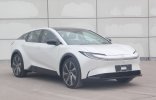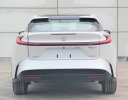You are using an out of date browser. It may not display this or other websites correctly.
You should upgrade or use an alternative browser.
You should upgrade or use an alternative browser.
Toyota EV/eTNGA Rumor Thread
- Thread starter ssun30
- Start date
internalaudit
Expert
- Messages
- 1,227
- Reactions
- 1,180
At least there will be three-row crossover coming from Toyota by 2026. Baby steps but the more choices the better.
Baby steps you say… that seems fleet-footed compared to their RWD cars that move at the pace of a sea anemone.At least there will be three-row crossover coming from Toyota by 2026. Baby steps but the more choices the better.
internalaudit
Expert
- Messages
- 1,227
- Reactions
- 1,180
Yeah, sad but I've got to save up anyway lol for my dream car. Nikkei is close to history highs maybe it will usher in the 80's era when Japanese cars reigned supreme.Baby steps you say… that seems fleet-footed compared to their RWD cars that move at the pace of a sea anemone.
F1 Silver Arrows
Expert
- Messages
- 2,572
- Reactions
- 4,180
200kw for an EV like that is pretty good. Does anyone know if Toyota's future batteries/motors can sustain more power like this?It's actually bigger than BZ4X and slightly heavier. The wheelbase is same as BZ3.
The motor is a 200kW model from BYD. Same as BZ3 but a more power variant.
Here are specs for their current batteries and motors:200kw for an EV like that is pretty good. Does anyone know if Toyota's future batteries/motors can sustain more power like this?
Panasonic 71.4kWh: 900A peak current/320kW peak power
CATL 72.8kWh: 750A peak current/266kW peak power
BYD LFP 65.5kWh: 660A peak current/230kW peak power
Blue Nexus 4KM: 150kW peak (30s)/57kW sustained (30min)
Blue Nexus 1XM: 150kW peak/73kW sustained
Blue Nexus 1YM: 80kW peak/59kW sustained
BYD TZ200: 180-200kW peak/90kW sustained
They could already build a 300kW EV with current parts. That's why the RZ600e concept exists. I'm confident they planned to have this model but had to cancel it because of poor range.
Their Bipolar NiMH technology has about 2X discharge rate (50C) compared to the conventional design (25C). If they can replicate that improvement on their bipolar Li-ion batteries we may see their flagship battery easily in the 800kW+ range on a 800V architecture. How much of that potential they will actually use is anyone's guess.
F1 Silver Arrows
Expert
- Messages
- 2,572
- Reactions
- 4,180
Thank you!Here are specs for their current batteries and motors:
Panasonic 71.4kWh: 900A peak current/320kW peak power
CATL 72.8kWh: 750A peak current/266kW peak power
BYD LFP 65.5kWh: 660A peak current/230kW peak power
Blue Nexus 4KM: 150kW peak (30s)/57kW sustained (30min)
Blue Nexus 1XM: 150kW peak/73kW sustained
Blue Nexus 1YM: 80kW peak/59kW sustained
BYD TZ200: 180-200kW peak/90kW sustained
They could already build a 300kW EV with current parts. That's why the RZ600e concept exists. I'm confident they planned to have this model but had to cancel it because of poor range.
Their Bipolar NiMH technology has about 2X discharge rate (50C) compared to the conventional design (25C). If they can replicate that improvement on their bipolar Li-ion batteries we may see their flagship battery easily in the 800kW+ range on a 800V architecture. How much of that potential they will actually use is anyone's guess.
I am not quite well-versed with the engineering behind electric motors/batteries compared to ICE vehicles so a lot of this will go over my head, but have you seen any improvements in power, charging, and range with regard to the new prismatic batteries coming out of Toyota in ~2026?
A very interesting development going on in the Chinese market is how quickly cars have grown in size in two years. The price war made mid-size cars so cheap (starting at just below ¥100k/$15k) that subcompact and compact cars have almost gone extinct. The only small cars left are kei-EVs for urban commute only. The "compact" segment is now at least 4.7m long and the "midsize" segment is over 4.9m long. This new BZ3c is the successor to C-HR EV but it's over 40cm longer. It's longer than the Harrier/Venza and approaching the Camry. The FT-3e concept (successor to BZ4X) will also grow to almost the same size as Lexus RX.
They promised a lot but their starting point is pretty low so I don't know how to interpret their claims. If they hit all their targets for 2026 they will be competitive with the market.I am not quite well-versed with the engineering behind electric motors/batteries compared to ICE vehicles so a lot of this will go over my head, but have you seen any improvements in power, charging, and range with regard to the new prismatic batteries coming out of Toyota in ~2026?
F1 Silver Arrows
Expert
- Messages
- 2,572
- Reactions
- 4,180
Much appreciated.A very interesting development going on in the Chinese market is how quickly cars have grown in size in two years. The price war made mid-size cars so cheap (starting at just below ¥100k/$15k) that subcompact and compact cars have almost gone extinct. The only small cars left are kei-EVs for urban commute only. The "compact" segment is now at least 4.7m long and the "midsize" segment is over 4.9m long. This new BZ3c is the successor to C-HR EV but it's over 40cm longer. It's longer than the Harrier/Venza and approaching the Camry. The FT-3e concept (successor to BZ4X) will also grow to almost the same size as Lexus RX.
They promised a lot but their starting point is pretty low so I don't know how to interpret their claims. If they hit all their targets for 2026 they will be competitive with the market.
qtb007
Admirer
- Messages
- 537
- Reactions
- 816
I think a lot of Japan's BEV decisions can be traced back to their (over)optimization when it comes to vehicle spec. The bZ4x could have the RZ450h powertrain for basically minimal impact to range since the EPA cycle doesn't require the vehicle to be driven at max performance. From Toyota's perspective, though, the Rav4 gets by with 220hp... why would the bZ4x owner ask for more? Same with `battery size and range spec. They look at what people actually need and set the spec to that. 220mi range is truly enough for most people that have any sense when they think about how they actually use their vehicles. My household could have a bZ4x today without missing a beat. We'll take road trips in the Lexus anyway. My brother had a Kia EV6. It was like 300 miles range and charged super fast on DC if needed. Guess how many times he charged it on a DC fast charger? 2 times in 28 months. Guess how many times he drove it further than 100 miles away? Once. He took his wife's Highlander hybrid on road trips because it had way more space inside and he didn't have to consider charging on the go at all. Saving a little gas money on a road trip doesn't matter to someone that can afford a $50k BEV and a $50k HEV CUV. Single vehicle households probably generally won't consider a BEV in the first place.
Now, is this the right way to spec BEVs? Probably not based on the fact that Toyota and Lexus BEVs don't sell well. When looking at how the vehicles are actually used and the demographics that purchase them, Toyota has a very logical approach. Logic isn't the driver in what cars sell well versus ones that don't, though. BEV buyers, even though they don't need it, have decided that range and DC fast charging is the most important spec. It's actually a lot like the truck and off road SUV market. Most people need the capacity they purchase 0.001% of the time. But they're willing to pay for it regardless and will make their decisions based on the "what if".
Now, is this the right way to spec BEVs? Probably not based on the fact that Toyota and Lexus BEVs don't sell well. When looking at how the vehicles are actually used and the demographics that purchase them, Toyota has a very logical approach. Logic isn't the driver in what cars sell well versus ones that don't, though. BEV buyers, even though they don't need it, have decided that range and DC fast charging is the most important spec. It's actually a lot like the truck and off road SUV market. Most people need the capacity they purchase 0.001% of the time. But they're willing to pay for it regardless and will make their decisions based on the "what if".
Last edited:
I wonder if the advent of evs offering access to yesteryear supercar levels of performance will make them reevaluate what passes as acceptable level of performance in even a corolla cross or rav4.I think a lot of Japan's BEV decisions can be traced back to their (over)optimization when it comes to vehicle spec. The bZ4x could have the RZ450h powertrain for basically minimal impact to range since the EPA cycle doesn't require the vehicle to be driven at max performance. From Toyota's perspective, though, the Rav4 gets by with 220hp... why would the bZ4x owner ask for more? Same with `battery size and range spec. They look at what people actually need and set the spec to that. 220mi range is truly enough for most people that have any sense when they think about how they actually use their vehicles. My household could have a bZ4x today without missing a beat. We'll take road trips in the Lexus anyway. My brother had a Kia EV6. It was like 300 miles range and charged super fast on DC if needed. Guess how many times he charged it on a DC fast charger? 2 times in 28 months. Guess how many times he drove it further than 100 miles away? Once. He took his wife's Highlander hybrid on road trips because it had way more space inside and he didn't have to consider charging on the go at all. Saving a little gas money on a road trip doesn't matter to someone that can afford a $50k BEV and a $50k HEV CUV. Single vehicle households probably generally won't consider a BEV in the first place.
Now, is this the right way to spec BEVs? Probably not based on the fact that Toyota and Lexus BEVs don't sell well. When looking at how the vehicles are actually used and the demographics that purchase them, Toyota has a very logical approach. Logic isn't the driver in what cars sell well versus ones that don't, though. BEV buyers, even though they don't need it, have decided that range and DC fast charging is the most important spec. It's actually a lot like the truck and off road SUV market. Most people need the capacity they purchase 0.001% of the time. But they're willing to pay for it regardless and will make their decisions based on the "what if".
-
This site uses cookies to help personalise content, tailor your experience and to keep you logged in if you register.
By continuing to use this site, you are consenting to our use of cookies.



